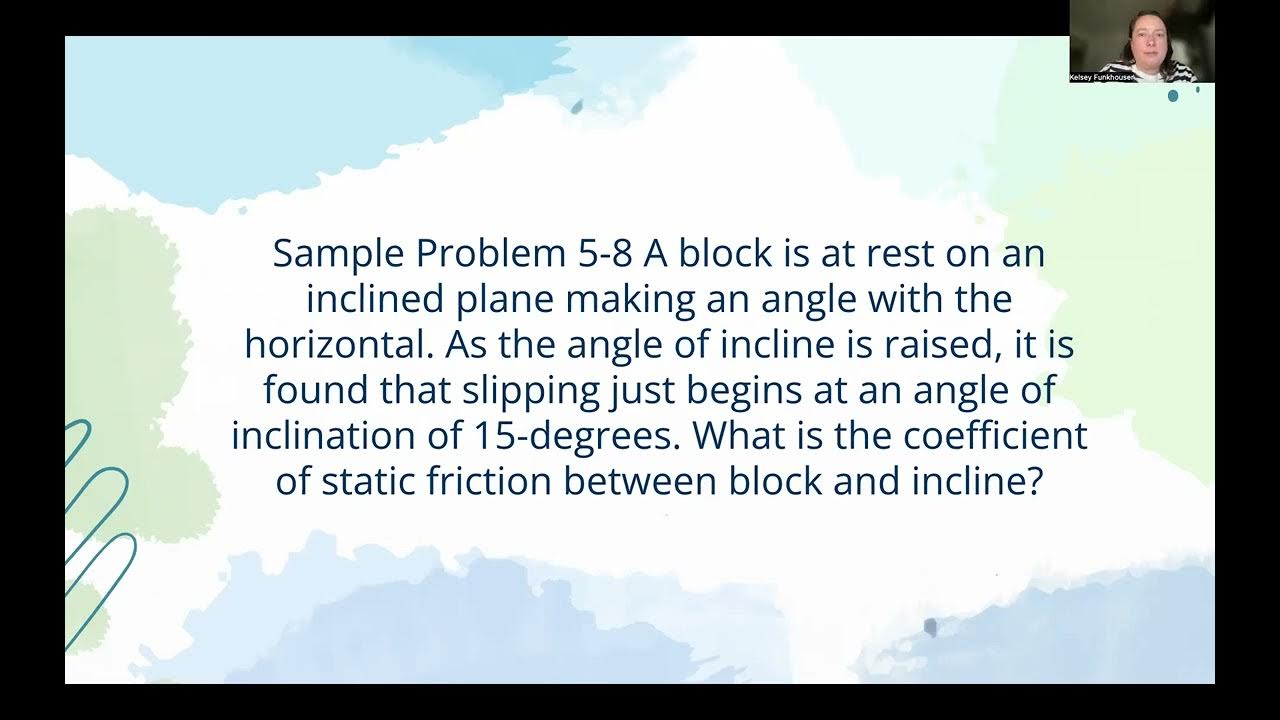Contoh Soal FISIKA SMA - Gaya Gesek Kinetis dan Statis
Summary
TLDRIn this educational video, the concept of friction and motion is explored using a physics problem. The scenario involves a 10 kg iron container placed on a flat surface, subjected to a 40 N force for 5 seconds. The video explains how friction, both static and kinetic, affects the container's motion. Through calculations, it shows how the container accelerates initially and then slows down due to friction after the force is removed. The friction force, deceleration, and resulting velocity changes are all examined, leading to the conclusion that the container stops after 10 seconds. The video emphasizes the importance of understanding friction in real-life motion scenarios.
Takeaways
- 😀 The problem involves a steel container with a mass of 10 kg on a flat surface, initially at rest, being pushed with a force of 40 N for 5 seconds.
- 😀 The coefficient of static friction (μs) is 0.3, and the coefficient of kinetic friction (μk) is 0.2 between the container and the surface.
- 😀 The gravitational acceleration is assumed to be 10 m/s² for simplicity in calculations, even though it’s typically 9.8 m/s².
- 😀 During the first 5 seconds, the applied force of 40 N accelerates the container at 4 m/s², as calculated using Newton's second law.
- 😀 After 5 seconds, the applied force is removed, and the container experiences deceleration due to kinetic friction, which exerts a 20 N force on the container.
- 😀 The deceleration caused by kinetic friction is 2 m/s², calculated from the force of kinetic friction divided by the mass of the container.
- 😀 The velocity of the container after 5 seconds of acceleration is 10 m/s, as it started from rest and accelerated at 4 m/s².
- 😀 After the force is removed, the container decelerates at a rate of 2 m/s² for the next 5 seconds, which causes it to stop.
- 😀 Using the equation of motion, the final velocity after the deceleration phase is 0 m/s, meaning the container comes to a complete stop after 10 seconds.
- 😀 The problem showcases the transition from constant acceleration to deceleration due to friction, emphasizing how kinetic friction slows down the motion of an object.
Q & A
What is the mass of the container in the problem?
-The mass of the container is 10 kg.
What is the constant force applied to the container during the first 5 seconds?
-The constant force applied to the container is 40 N.
What are the coefficients of static and kinetic friction between the container and the flat surface?
-The coefficient of static friction is 0.3, and the coefficient of kinetic friction is 0.2.
What is the value of gravitational acceleration used in this problem?
-The value of gravitational acceleration is taken as 10 m/s².
How does the container's velocity change during the first 5 seconds?
-During the first 5 seconds, the velocity of the container increases due to the constant force of 40 N applied to it.
What happens after the 5 seconds when the force is no longer applied?
-After 5 seconds, the container starts to decelerate because only the kinetic friction force is acting on it.
What is the value of the kinetic friction force acting on the container?
-The kinetic friction force acting on the container is 20 N.
How do you calculate the acceleration when the container is moving?
-The acceleration is calculated using the formula: net force = mass × acceleration, where the net force is the applied force minus the kinetic friction force.
What is the acceleration of the container after 5 seconds when no external force is applied?
-The acceleration after 5 seconds is -2 m/s², indicating a deceleration due to friction.
What is the final velocity of the container after it has been moving for 10 seconds?
-The final velocity of the container after 10 seconds is 0 m/s, as it comes to a stop due to friction.
Outlines

This section is available to paid users only. Please upgrade to access this part.
Upgrade NowMindmap

This section is available to paid users only. Please upgrade to access this part.
Upgrade NowKeywords

This section is available to paid users only. Please upgrade to access this part.
Upgrade NowHighlights

This section is available to paid users only. Please upgrade to access this part.
Upgrade NowTranscripts

This section is available to paid users only. Please upgrade to access this part.
Upgrade NowBrowse More Related Video

Fuerza de fricción o rozamiento

Friction: Crash Course Physics #6

PHYS 121 - Week 4 Lecture 2 - Friction & Circular Motion

Science 6 Quarter 3 Module 1 Lesson 1 - Describe Friction

Two particles of masses m_1 and m_2 are tied to the ends of an elastic string of natural length a..

Balanced & Unbalanced Forces | Forces & Motion | Physics | FuseSchool
5.0 / 5 (0 votes)